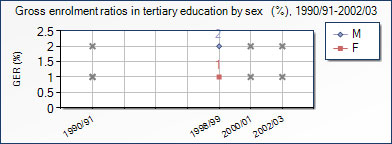Pocket statistics: Tertiary Education in The Gambia
From WikiEducator
Contents
Overview of the tertiary education system in The Gambia
The country has a population of approximately 1,388 000 people with 68% reported to reside in rural areas and 41% of the population between 0 and 14 years of age. Over the last decade, the average regional enrolment of males and females in tertiary education was 5% (2002/2003). Exact figures not available.
Tertiary Gross Enrolment Ratio Statistics
| 1990/91 | 1998/99 | 2000/01 | 2002/03 | VUSSC Average | |
| MF Total | - | 1% | - | - | - |
| Male | - | 2% | - | - | - |
| Female | - | 1% | - | - | - |
There are XX government funded tertiary education institutions in the country providing learning opportunities for XX students. A strategic priority for The Gambia's tertiary system is ...... Say something about ICT infrastructure and opportunities and challenges for elearning.
Government funded Tertiary Education Institutions
Department of State for Education (Banjul)
| Name of Institution | Department of State for Education |
| Website | Eg http://www.col.org |
| Type of Institution | Eg. University, Polytechnic, Community College etc |
| Main mode of delivery | Eg. Campus-based, Single mode DE, Mixed Mode etc. |
| Number of students | State number of students and year here, eg 13 547 (2004 fugures) |
| Learning Management System(s) | For example ATutor, Moodle, KewlNextGen, Blackboard, WebCT etc. |
| Overview of e-learning | Enter brief description of e-learning activities at the institution |
Gambia Technical Training Institute (Banjul)
| Name of Institution | Gambia Technical Training Institute |
| Website | http://www.gtti.gm/index2.html |
| Type of Institution | Eg. University, Polytechnic, Community College etc |
| Main mode of delivery | Eg. Campus-based, Single mode DE, Mixed Mode etc. |
| Number of students | State number of students and year here, eg 13 547 (2004 fugures) |
| Learning Management System(s) | For example ATutor, Moodle, KewlNextGen, Blackboard, WebCT etc. |
| Overview of e-learning | Enter brief description of e-learning activities at the institution |

